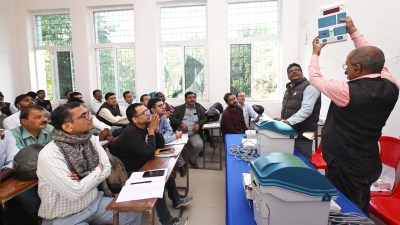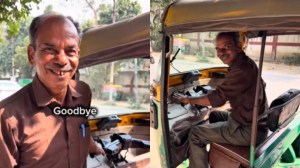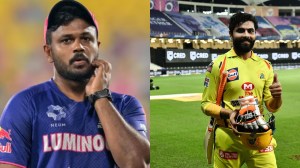We were able to account for seven and were looking for the eighth terrorist… our dogs smelt out the body,beneath burnt furniture
In this interaction with <B>The Indian Express</B> <B>Editor-in-Chief</B> <B><font color"#cc000">Shekhar Gupta</font></B> on <B>NDTV 24x7s Walk the Talk</B>,<B>former NSG chief</B> <B><font color"#cc000">J K Dutt</font></B> relives the 26/11 operation at the Taj,Mumbai. Dutt says the NSG was not short of ammunition,but had to factor in the possibility of collateral damage
•We are in front of a landmark (Taj Hotel,Mumbai) that will remain imprinted in our memories for the harrowing times we had watching it on television for three-and-a-half days. My guest this week is J K Dutt,former Director General of the National Security Guard,under whose command the siege was brought to a logical conclusion and a bloody one. Welcome to Walk the Talk.
Its nice to be here with you.
•Its also sobering to be here.
Very much.
•Its also wonderful to have you speaking for the first time on what happened.
This is something that has given me a sense of accomplishment at the time of my retirement. In fact,I would say that Operation Black Tornado was almost a vindication of all the…
•…There was only one operation.
Yes. Surprisingly,the media at that time had said that there is an Operation Cyclone,an Operation Weather Storm. But the entire operation at Nariman House,Oberoi and Taj hotels was Operation Black Tornado.
•Tell us how it started.
I was watching television and the first thing I heard on the news was that there was some gang war. But from the way the shooting was going on and some of the shots they were showing,I could make out that this was a terrorist attack. I immediately asked my commandos to get ready and soon after that I received a call from the Cabinet Secretary saying that probably the NSG will be required and the team should be ready. As soon as that happened,I felt we should move our men to the airport.
•How fast does it happen in the NSG?
We give them 30 minutes to prepare. Once the alert has been sounded,they come,collect their weapons and other equipment,and proceed to the vehicles. It takes about 30 minutes for that. All other equipment is loaded in the vehicle and they go to the airport. The NSG is situated at Manesar,which is 35-40 km from the airport and,depending on the traffic,it takes almost an hour or more to reach the technical area.
•The technical area is the one which the Air Force uses at Palam airport.
Yes. The vehicles were ready and the men got into them. By the time the request came from the state Government to the Home Ministry,the men were already on the move. Then,the question of having an aircraft arose. The aircraft,an IL-76,which can carry 200 persons with ammunition,was available.
•What happened at that time? The plane did not come from Chandigarh?
No,the aircraft was available at the Indira Gandhi International airport and we were ready by 2.10 am. Then,we were told that the aircraft will take off at 2.20 am. Once the men are inside and the hatch is closed,the aircraft begins its checklist of switching on,etc,and that takes about 25-30 minutes. Even a helicopter takes 10-15 minutes to warm up. We took off from New Delhi at 3 am and by 5 am we were here.
•How much did you know at that time?
We knew that three places had been attacked. TV had also told us about the attacks at Leopold Café,VT station,Cama Hospital. By the time we left,it had more or less got confined to the Taj,Oberoi,and Nariman House. We looked upon it as three venues. It was only after we came here that we realised that it is not just Taj Heritage but also Taj Tower and we also have the Oberoi along with the Trident.
•You were not particularly familiar with Mumbai.
No.
•When you were with the CBI,you used to keep raiding government officers here.
That was a different job altogether. By the time we came here,it was almost like five venues and our operation started with the Trident.
•The time lag between your getting the orders and your troops getting to these places could have been shortened?
There are two ways of looking at it. One,if you look at the time when the terrorists attacked,that will be around 9 pm or 2100 hours of November 26,and as I mentioned,first they thought it was a gang war. It was only later that they confirmed that this was an act by terrorists and once that happened the state machinery got into motion. They had to get the clearance from the Chief Minister who requisitioned the NSG. We started our operation on November 27 at 9 am. But if you look at it from the time that we took off from Delhi after we had received orders for moving to this place,then we got the order at about 1 am and by 3 am we were in the aircraft,by 5 am we were here,by 9 am the operation had started. I had been able to talk to the DG Maharashtra and they had lined up all the vehicles we required.
•Was he holding his nerve or was he shaken?
He was quite in control of himself. Probably,the ATS was hard hit and the situation was becoming more and more difficult for the local authorities to deal with.
•If the ATS had not lost its top brass,maybe they would have reacted better?
Its difficult to talk in ifs in a situation like this. The strength of the ATS is also not very large. The training that is required,the mental makeup of the men,the weapons they use,the fire power that is required in an operation like this probably all that was not available. Last year,in our country there were only one or two forces which were equipped with all sorts of things. The Greyhounds in Andhra Pradesh,for example,have that sort of capability and have been trained by the NSG. Since Operation Black Tornado,we have been receiving requests from almost all the states to train their men. We have to set up the hubs as quickly as possible. Hubs are coming up in Hyderabad,Kolkata,Mumbai and Chennai. The hubs should be as close to the airport as possible. We also need firing ranges,obstacle courses,auditoriums,training areas.
•What was it that you first saw when you came here?
In the aircraft,I had briefed my officers. I told them that we must ensure that there is no loss of innocent lives,no hostages. Second,we should try and keep the collateral damage to the minimum. Third,we try to take the terrorists alive. Fourth,once we leave the place it should be safe for others to use it,no unused grenades that can go off injuring innocent persons. When we came here,we had to dissipate the force a bit to get in another contingent from Delhi. Once the second team was with us,we were able to launch a full-scale operation. The Mumbai Police already had Kasab in their custody. He had been examined and from him,we were able to get information that there were at least 10 terrorists. There was also speculation regarding local contacts. This information was being verified by certain agencies. The NSG is only meant for conducting operations,engaging terrorists and neutralising them. Like the celestial Sudarshan Chakra,we go in quickly and get out,we dont linger around any operation.
•Thats the symbolism behind the Sudarshan Chakra?
Yes. The celestial weapon can cut through anything and when it meets with resistance,its speed increases.
•When the NSG went in,did you worry that there might be more people inside?
Yes. We have instances where terrorists booby-trap dead bodies. Those are the first things one tries to remove,and when one is trying to do that,it can cause an explosion. Inputs were given to us by the state force and the intelligence department. We had to separate terrorists from guests and the hostages,because as long as these persons were together,to some extent there could be casualties. We found that the rooms had been set on fire. On the second day,I realised that this was a diversion tactic. They came under pressure and set a room on fire,as that gave them time to reload,rest,recuperate and eat. They were highly trained terrorists and not just picked up,given rudimentary training for a few days,and sent off to conduct an operation like this. We had a few instances where the firemen came face to face with the terrorists. Surprisingly,though the terrorists were killing anyone they saw,they did not fire at the firemen. This was one thing we took advantage of.
•Did you change your tactics once you discovered that they were using fire to escape and to recover from pressure?
Twice,I had a re-look at my tactics. One was when I lost Major Unnikrishnan at the Taj. He took a very big risk. Risk-taking cannot be taught,for a person acts out of emotion at that time and if the emotional bank account is high,he will risk anything.
•What exactly happened with Major Unnikrishnan?
The terrorists were on the first floor near the landing and they were shooting from the staircase. They were positioned on the landing on the first floor. They had engaged the NSG team and when they advanced,one of the commandos was injured and fell down the staircase. Unnikrishnan,along with his team,immediately rushed to rescue him. Unnikrishnan was right in front. He was able to rescue the man and hand him over to his team mates. The fire was coming from the landing. He decided to go after the terrorists alone. His buddy was taking care of the injured person.
•Thats not exactly your training. The training is that two should be together as far as possible. A buddy pair should not break.
Yes,but a situation like this has its demands and opportunities that can be exploited. I think thats what Unnikrishnan did. Had Unnikrishnan succeeded,probably the entire operation would have been terminated much faster. He went up to the first floor and from there he was able to engage the terrorists. At that time,the number of terrorists was not known. We knew there were two,but there was,in fact,a third one inside a room. When Unnikrishnan was chasing one of the terrorists who was trying to retreat,he came in front of the room where the third terrorist was hiding and that,unfortunately,got him. There was nothing wrong in the tactics. Here was an NSG commando,who was acting beyond the call of duty. Every time,an operation takes place,one thinks that nothing will happen to me and one casualty occurs then others think,it can be me next time. It was very necessary that even while the shooting was going on I visit the place. My commandos and officers were able to push the terrorists out,we went to that landing. I found there was nothing wrong with the tactics and quietly the word was spread that this person (Unnikrishnan) has sacrificed his life and it will not be wasted.
•This was effectively your first contact with the terrorists.
Yes.
•At the Oberoi,the fighting was much more intense.
At the Oberoi,though there were only two terrorists,the fighting was very intense because they were using high-explosive grenades,AK-47s. Each terrorist was armed with two weapons AK 47 and .9 mm Chinese pistol and of course,the hand grenades were there. They had a number of spare magazines. If these terrorists had wanted,they could have prolonged the operation. On the 29th,we had got the Nariman House and the Oberoi under our control. At the Taj,when I found out the tactic of setting fire was being used,I told my men that as soon as the fire is out they must enter the place and spring a surprise on the terrorists by firing first. Till then,it was only single shots that were being fired.
•Why would you use single shots? You were not short of ammunition?
We were not short of ammunition,but the question was that of collateral damage. There was no point shooting at shadows.
•When you figured out that setting fire was a tactic,did you decide to use overwhelming fire-power?
One,we decided not to allow these persons to get out. Secondly,when the firemen were dousing the fire from outside,our persons were already in different passages. The only thing we did not know about was the spiral steel staircase inside. We knew that some structure was there,but we were told very late that it is actually a staircase. I must say this building is absolutely strong,and bullets hardly had any effect on the foundation. We went in for the burst fire and thats when I think we were able to neutralise all of them.
•When did you know that they were all cornered in one place?
After the fire had been put out and we had mounted the assault,20 minutes after that one of the terrorists had fallen and then there was silence,there was no return fire. We knew then that they have either been neutralised or they may have changed positions. And when we went in,we found three bodies,two of them near the staircase. I got in touch with the IB over the phone and asked the Director,Look,how many terrorists are we supposed to account for?. The rooms had to be checked. I did not want to open a door,someone could come out shooting and we could have had unnecessary casualties. Over 600 hostages had been rescued and we lost two men. Eight terrorists had been killed. The IB Director said we had to account for 10,out of which Kasab was already in custody and one of the terrorists had been killed by the police. We were able to account for seven and were looking for the eighth terrorist. I told my men to be very cautious. We sent in our dog squad to look at the grenades and other things lying around which had to be defused. The dogs smelt out the body of the terrorist,it was covered with burnt furniture. They found the body and when we cleared all the debris we found the weapon,an AK-47.
•So,dogs were also flown out with your first batch?
Yes,we brought one dog in the first batch and another one or two came in the second flight.
•This was just one-third of the operation that you had undertaken. Lets also take a look at the Oberoi thats an operation which did not get so much of attention.
I think that is because at the Oberoi,the media was kept at a little distance. I would say even the media had taken a risk by being here.
To be concluded next week.
Transcript prepared by Manjusha Madhu.



- 01
- 02
- 03
- 04
- 05



























